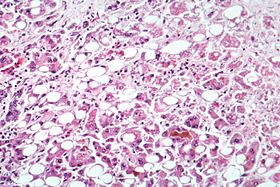Chronic hepatitis
| Hepatitis | |
|---|---|

|
|
| Specialty | infectious disease, gastroenterology |
| Symptoms | yellowish skin, poor appetite, abdominal pain |
| Duration | short term or long term |
| Causes | viruses, alcohol, toxins, autoimmune |
| Prevention | vaccination (for viral hepatitis only) |
| Treatment | medication, liver transplant |
| Frequency | > 500 million cases |
| Deaths | > one million a year |
| Classification | |
|---|---|
| External resources |
Hepatitis is inflammation of the liver. Some people have no symptoms whereas others develop yellow discoloration of the skin and whites of the eyes, poor appetite, vomiting, tiredness, abdominal pain, or diarrhea. Hepatitis may be temporary (acute) or long term (chronic) depending on whether it lasts for less than or more than six months. Acute hepatitis can sometimes resolve on its own, progress to chronic hepatitis, or rarely result in acute liver failure. Over time the chronic form may progress to scarring of the liver, liver failure, or liver cancer.
The most common cause worldwide is viruses. Other causes include heavy alcohol use, certain medications, toxins, other infections, autoimmune diseases, and non-alcoholic steatohepatitis (NASH). There are five main types of viral hepatitis: type A, B, C, D, and E. Hepatitis A and E are mainly spread by contaminated food and water. Hepatitis B is mainly sexually transmitted, but may also be passed from mother to baby during pregnancy or childbirth. Both hepatitis B and hepatitis C are commonly spread through infected blood such as may occur during needle sharing by intravenous drug users. Hepatitis D can only infect people already infected with hepatitis B.
...
Wikipedia
